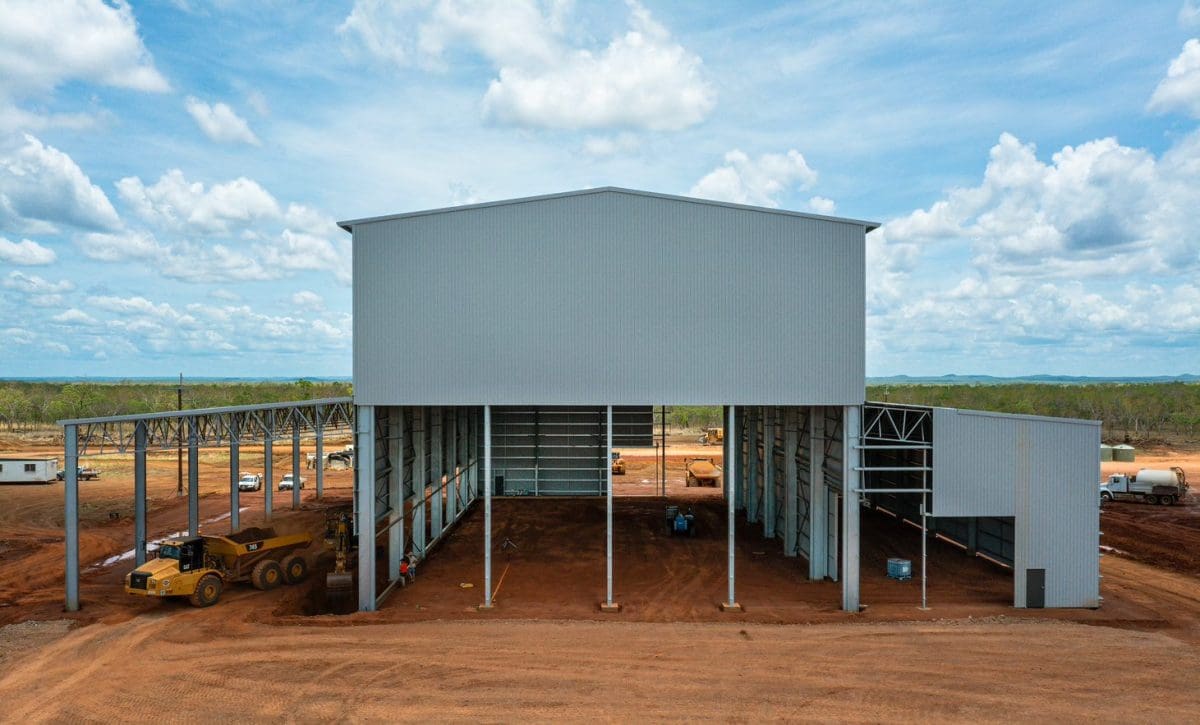
The Northern Territory’s first cotton gin is taking shape near Katherine. Photo: Entegra Signature Structures
CONSTRUCTION of the Northern Territory’s first cotton gin is well under way, with the facility on track to start operating in July next year.
Riverina-based and grower-owned company RivCott has been employed to build and operate the facility, with Entegra Signature Structures now constructing the buildings.
WANT Cotton Company Pty Ltd – a group of Western Australian and Northern Territory cotton growers – has engaged RivCott chief executive Sam Buster as the project manager at the site 34km north of Katherine which was formerly part of Tarwoo Station.
Mr Buster said local growers have been optimistic about the gin and the budding cotton industry while southern cotton growers have recognised an opportunity.
“There are a lot of southerners coming in, looking to buy land, because they see the potential,” Mr Buster said.
“The opportunity that the growers and the people building and operating the gin have is to do something that hopefully will be very successful, for the very first time and in a brand-new industry for the Territory.”
Just-in-time difference
Growers delivering to RivCott’s gin at Carrathool, and others in established cropping regions of eastern Australia, aim to get their cotton to the gin as quickly as possible after picking.
However, the NT gin will be different in order to minimise the risk of fire on site, and because growers are not expected to be double-cropping their fields.
“In the Riverina everyone plants, behind cotton, wheat or a winter crop…but here, no-one plants anything behind it; it sits fallow, and it doesn’t rain in winter.”
“The gin site is also surrounded by trees and every year almost everything burns.”
Mr Buster said this was a consideration in how the gin would operate.
“They have bushfires and they plan on bushfires; there’s expectations that the land surrounding the gin will burn and cotton is highly flammable.”
While RivCott has held up to 30,000 round bales, or modules, in its gin yard at any one time, the NT gin will not.
“There’s no way you want to do that here, so our strategy is to feed the gin with just-in-time module freight …. we will never have more than a few days’ supply of modules in our yard to minimise the threat of fire.
“It will also make it cheaper and more efficient, with no downside to the grower.”
Special consideration has also been given to the location of the warehouse and the amount of lint, seed and trash stored on site.
The next NT cotton harvest is due to start in June.
Mr Buster expects the gin will produce 40,000-50,000 bales in its initial year of operation, and the first expansion will be considered when output gets to 60,000-70,000 bales.
“We are building the cheapest, smallest gin you can because that’s all we can afford and all we should have with the production, but it can quickly pivot and grow.”
Mr Buster said the building of the gin was a “complete chicken and egg” situation, and ginning in the opening years would not produce the 120,000 bales a year needed to underpin a viable processing operation.
“The gin will never overcapitalise; we will build a small, cost-effective gin and as the industry grows, they can capitalise up commensurate to the production.
“That’s the strategy and it’s built into the design of it all.”
The long-term plan for the gin is for eight stages of planned growth, with the initial ginning equipment to remain part of the operation as its capacity expands.
New ginning equipment from the US, and used equipment from the mothballed gin at Lake Tandou in south-western NSW are now arriving at the Katherine site.
Yield stacks up
Nearly all cotton currently being produced in the NT is rain-grown.
Mr Buster said indicative yields from the NT stack up well against up against dryland crops grown in sandy soils in other parts of the world, including the US state of Texas.
“They (Texas) average a bale an acre, about 2.4 bales a hectare,” he explained.
“Here it looks like they will average 3-5 bales a hectare.”
Mr Buster said the consistent 1000-1800 millimetre rainfall across the Northern Territory growing season would be “ample” for the dryland crop.
By comparison, he said a fully- irrigated cotton crop in the Bourke area of NSW uses only 900mm.
“Cotton takes about five months to grow and it only rains for 3.5 months.
“The yield is limited by the duration of the wet season.”
He said the colour of the lint produced during the NT’s three-year trial was “beautiful”, trash content was minimal, and the length and strength of the fibre was good, and the result of “perfect” harvest conditions.
For every 227-kilogram bale of cotton produced at the gin, around 250kg of cottonseed is recovered.
Cottonseed is high in protein and oil, and the commencement of ginning in the NT will make the prized feed locally available in volume to NT cattle for the first time.
Source: Entegra Signature Structures
